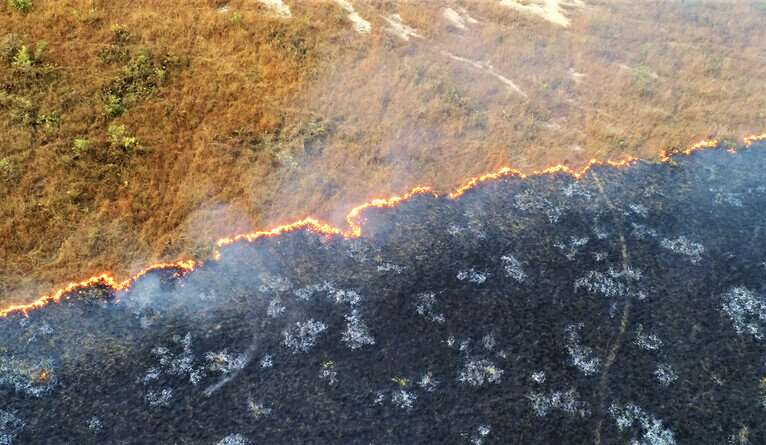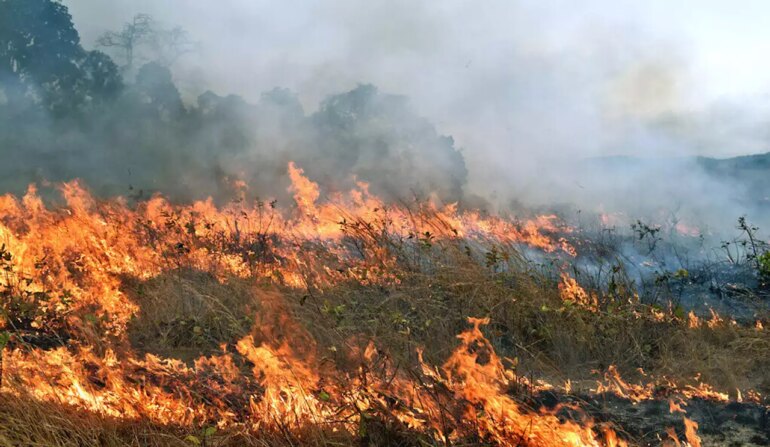Global climate change has already exacerbated the risk of fire and is likely to fuel even more change as accelerating feedback loops create disastrous consequences for both biodiversity and human populations. Yet accurately predicting the risks and impact of bush and wildfire globally is still a work in progress.
In a new study, a team of Yale scientists and colleagues from South Africa, Gabon, and the United States set more than 1,000 prescribed fires in grassy savannas, an ecosystem where more than 80% of the world’s fire activity occurs. Using the results of the experimental blazes, they tested a model that will help climate scientists to more accurately predict when and where changes to the expected frequency and intensity of fires are likely to occur, and how they will impact global climate change.
They report the results June 20 in the journal Proceedings of the National Academy of Science.
“Areas such as the American West and African savannas can suddenly switch from a nonflammable state to one where everything is burning, or vice versa,” said senior author Carla Staver, associate professor of ecology and evolutionary biology at Yale. “Predicting when that threshold will be crossed is crucial to understanding the impact fires have now and will have in the future.”
The Yale team led by Anabelle Cardoso, a former postdoctoral associate in Staver’s lab who is now at the University at Buffalo, set fires in Kruger National Park, in South Africa, and other savannas in Africa and the United States. They then measured variables such as grassy fuel biomass, moisture levels, air temperature, and humidity, as well as seasonal variables such as rainfall.

Monitoring fire spread from above shows how completely a landscape burns under favorable conditions. © Anabelle Cardoso
Their findings, they report, indicate that fire spread is analogous to the transmission of infectious diseases and can be modeled the same way that public health officials predict disease outbreaks. Like infectious diseases, fires require a source of “ignition” (someone who initially contracts the disease), a minimum of fuel to burn (enough people in the population who are vulnerable to becoming infected), and advantageous environmental conditions to spread quickly (a disease that is very contagious and a susceptible population that is not trying to minimize transmission).
“And like a person previously infected, an area that has burned gains ‘immunity’ to future fires until sufficient amount of fuel regrows,” Staver said. “Climate change affects this immunity because some places burn more and some stop burning. In both cases, biodiversity and ecosystem function is compromised.”
Fires thrive when moisture levels are low, temperatures are high, and humidity is moderate to low. All of these conditions can be exacerbated by climate change, the authors say. When environmental conditions reach a certain threshold in terms of available fuel and dryness, the risks of intense fires and dangerous fires can increase quickly.
“Thresholds are like switches. Once it’s flipped, everything changes quickly. It’s not gradual,” Cardoso said. “Fire risk does not go from ‘low’ to ‘dangerous’ in small increments. Rather it can go from ‘low’ to ‘everything-is-burning’ without any warning signs.”
Land managers with experience managing fires intuitively understand these fire thresholds and how quickly fire conditions can shift from safe to dangerous. However, many models used by scientists to predict the current and future global effects of fires don’t fully account for these thresholds and how much carbon is released during these burn events, which could make it difficult to accurately predict future fire risks, the authors say.
Intriguingly, the impacts of global change—especially drought—and an increase in livestock grazing have actually reduced the amount of fuel available for fires in some African savannas. However, other areas of the globe, including the American West, are at far greater risk of catastrophic fires because fuels are drying out more.
“The switch can work in both directions,” Staver said.
More information:
Quantifying the environmental limits to fire spread in grassy ecosystems, Proceedings of the National Academy of Sciences (2022). DOI: 10.1073/pnas.2110364119.
Citation:
Crossing fire threshold can quickly turn blazes dangerous (2022, June 20)



